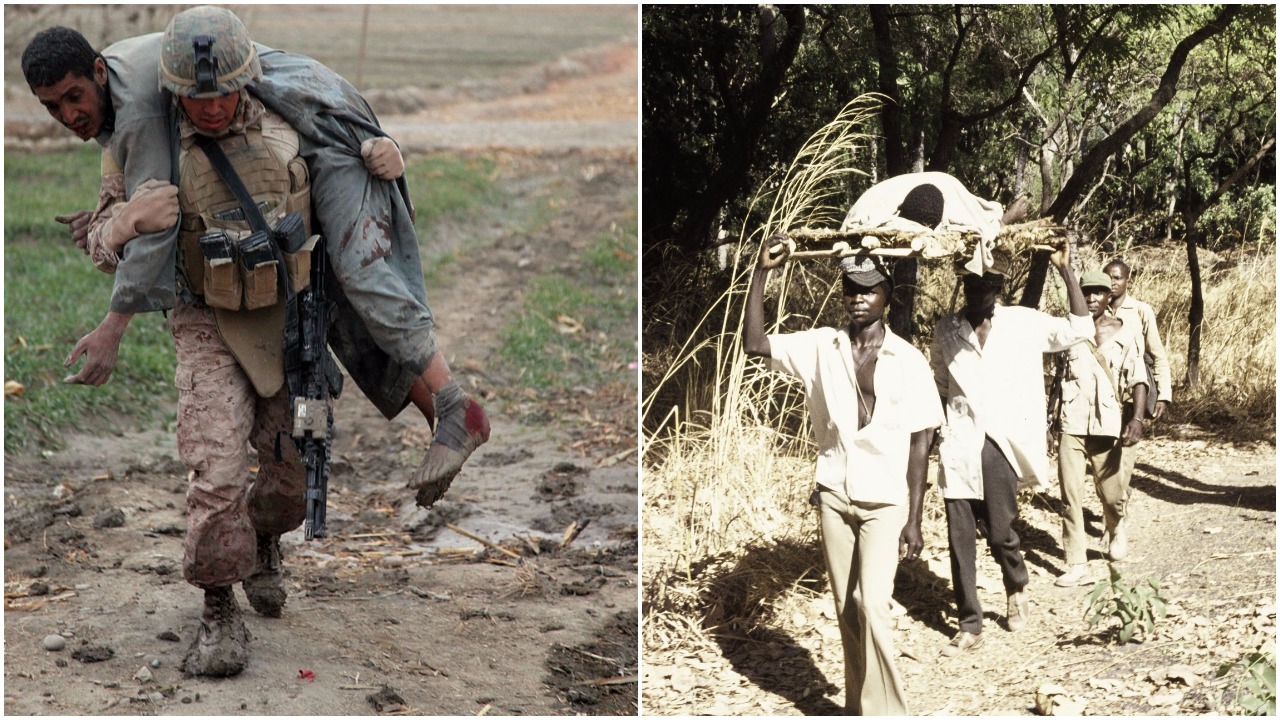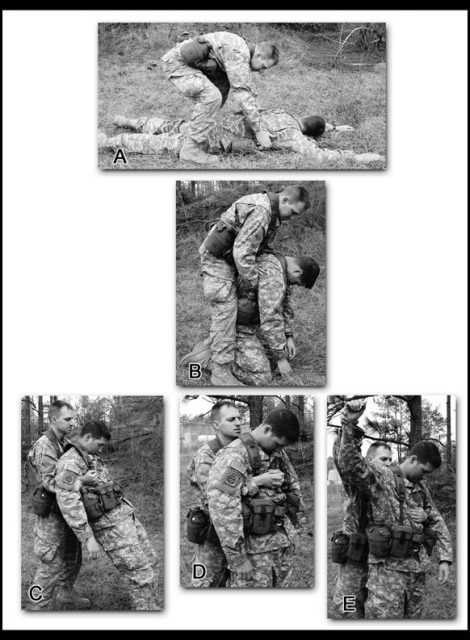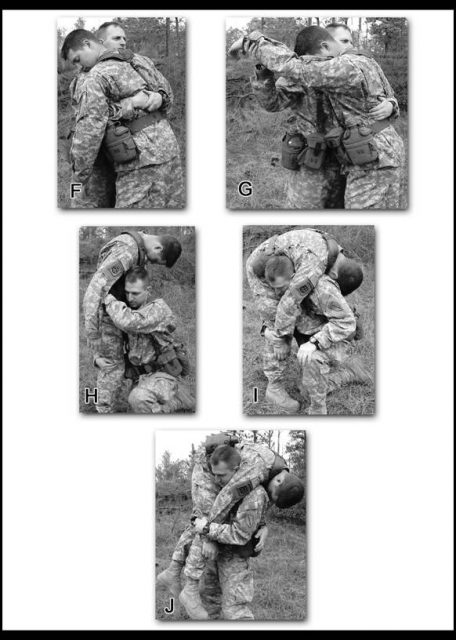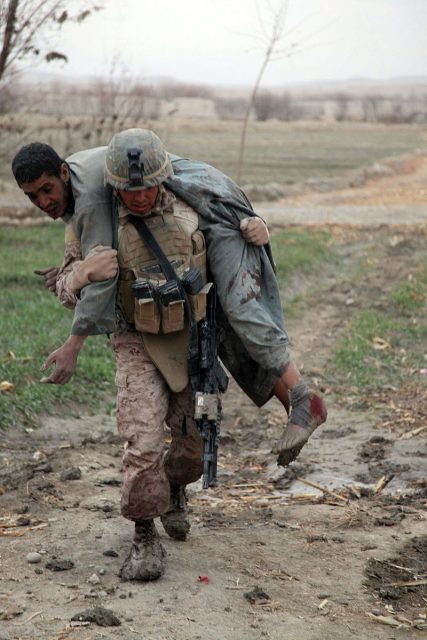How To Carry A Wounded Person In A Survival Situation

If you are in a survival situation or a disaster scenario, and a member of your group goes down with an injury that is bad enough that they cannot walk on their own, you may be faced with the task of carrying them out to safety.
Without a shadow of a doubt, the first thing that you need to do is assess the person’s injuries and give them first aid while keeping them as comfortable as possible. However, if the person’s injuries do not heal soon, you will be faced with a critical decision to make: do you leave the wounded person there with some provisions and then go out for help on your own, or do you try to carry them out yourself?
This article will tell you what to do if you determine, to the best of your ability, that the best course of action to take is to carry out or drag the person yourself. There are many different methods you can use to carry an injured individual from place to place, and we’ll cover a few of these methods in a moment. But first, let’s discuss when you absolutely should NOT carry a wounded person out.


WHEN NOT TO CARRY OR DRAG A WOUNDED PERSON OUT
It’s always a bad idea to try and carry someone out if he or she has suffered a spinal injury, especially if the injury is severe. Trying to carry someone with a spinal injury can dramatically increase both the pain and the damage of the injury, and if gone far enough, can potentially even cause them to become paralyzed. You want to avoid this from happening at all costs.
You can generally tell if someone has sustained a spinal injury if they are unable to move their neck, are informing you of extreme pain in their neck or their back, if their neck or head is twisted in any way, if they experience pain when flexing their limbs, or if they are experiencing paralysis or numbness in their limbs.
If someone in your group has suffered a spinal injury, stabilize them rather them out. Place cushions (made out of whatever resources you have) on both sides of their head so it won’t roll, use the jaw thrust method for opening their airway if they are experiencing difficulty breathing, and don’t take off their helmet if they were wearing one at the time of the injury (doing so can only make the spine worse).
With that being said, let’s examine some of the different methods you can use for carrying a wounded person out to safety if they haven’t suffered a spinal injury and if you feel, under your circumstances, that it’s a better option than leaving them with provisions and searching for help on your own.

METHOD #1 – FIREMAN’S CARRY
As the name suggests, this method of carrying a wounded person is the same one that is used by firefighters. Considering the fact that firefighters constantly find themselves involved in very complex situations and need to get people out to safety quick, it wouldn’t exactly be wise to hold the methods they use in low regard.
To use the fireman’s carry method, following these steps:
1. Bring the person up to their feet and hold them from behind their waist so that you are looking at them face to face; your dominant hand should be the one holding them
2. Using your other hand, grab the person by their wrist on the same side and raise their arm over their head
3. Squat down and position your knee on the side of your dominant hand between the person’s leg
4. Start to heft the person over your shoulders
5. While lifting the person, bring your arm to around their thighs and shift the weight of the person over your shoulders
6. Slowly stand while keeping your back as straight as it can be; you want your legs to be your primary source of lifting power
The firemen’s carry method is an effective way to lift and carry someone to safety, but it’s also best used for short term endeavors because it requires a lot of exertion on your part especially.
A safer method than actually lifting a person is to drag them. Lifting a person not only puts more weight on you, but it also means that the injured person runs the risk of falling off and becoming even more injured.
When dragging a person, you will want to keep them in a straight line so that their spine will not twist. There are three ways to drag someone: the clothing drag, the leg drag, or the arm drag method.
CLOTHING DRAG
The clothing drag method is best used if the person has injuries on both their arms and legs. The best place on the clothing to grab is underneath the armpits, because this is the least likely place for the clothing to tear when being dragged and it also keeps the injured person’s head above the ground. Always bend your knees and utilize your weight by leaning back when dragging someone.
LEG DRAG
The leg drag method should be only used when a person hasn’t sustained any leg injuries, but still cannot walk on their own. Your want your back to remain as straight as possible while dragging them, and the best way to do this is by grabbing them by their ankles. Then lean back and slowly drag the person away.
ARM DRAG
When a person has leg injuries, you should always use the arm drag method in place of the leg drag. Bend your knees and ensure that your back is kept straight when dragging the person. You can squeeze the elbows of the injured person against their head so that it does not drag. Again, you can use your own weight by leaning back and moving slowly to drag them away to safety.
If you have any comments then please drop us a message on our Outdoor Revival Facebook page
If you have a good story to tell or blog let us know about it on our FB page, we’re also happy for article or review submissions, we’d love to hear from you.
We live in a beautiful world, get out there and enjoy it.
Outdoor Revival – Reconnecting us all with the Outdoors.
